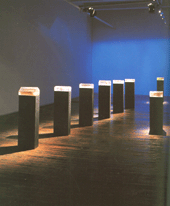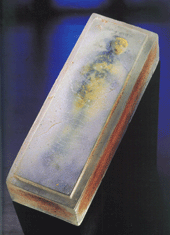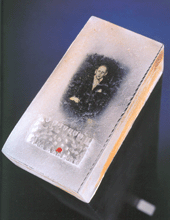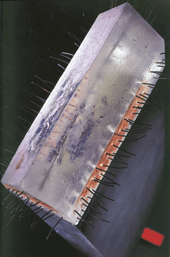|
In
December 2000, an exhibition titled Sleeping/Waking was held at
the William Traver Gallery in Seattle, USA. Despite the setback,
it is probably Vallien's most powerful exhibition.
- It
was an attempt at an exhibition unrelated to my earlier work, such
as boats and heads. The central theme was "sleeping - waking".
Sarcophagi and blocks of ice. The ice blocks were about the desire
for immortality and were inspired by Mr. Moro, the Japanese gentleman
who allowed himself to be frozen in a block of ice.
There
was this company named Cryogenic, whose business concept was the
freezing of human organs and corpses, in the hope that Science would
one day be able to restore them to life. It cost 1,000 dollars for
a whole-body refrigeration (in an ice-block); with a rebate for
families. The company went bankrupt.
The visitor
to the exhibition steps into a blue room, where some dozen blocks
rest on black wooden bases. One can, to a certain extent, understand
the cool reaction of the audience. It is a frightening environment,
and the blocks can be mistaken for coffins. The American art critic,
Matthew Kangas, describes the exhibition in his book "Sleeping/Waking".
In Kanga's opinion the contrasts that Vallien works with emphasise
the theme of the exhibition very well and the ambiguity enhances
the visitors' interest.
One of
the chosen subjects is 'the man'. In Mr. Moro1, Provenance and Singular
they are naked and vulnerable. To portray the confusions of wounded
masculinity is a topical theme (sign of the times). 'Mr. Moro' represents
something different: man's desperate struggle for immortality. Both
in life and in death. In Kanga's interpretation, the men (and their
masculinity) in the pieces are not only victims of social circumstances.
The question is far more complex than so. What drives a person's
ego? 'Claude Cahun' is a portrait of the French artist who dressed
up as a man? Here Vallien takes up a neo-classic* art form: that
of sexual ambivalence and a game of gender-roles. This type of expression
is fairly common in the world of rock music. The different faces
of David Bowie over the decades is one example; another is Kurt
Cobain of Nirvana who, during the masculine Grunge trend emphasised
his softness by donning a dress and singing introverted texts.
In another
block, such as Passage, The Barn, and Horn, Kangas finds traces
of the old Swedish agricultural society. He sees Vallien as one
of the most challenging artists of our time; he is among those who
are not content just to create a beautiful object; but rather an
autonomous piece of work imbued with a soul, that we call art.
-A figure cast in glass...is so implacably immortalized, more so
than in a painting or a drawing. The transparent material, melted
by ferocious heat, and within it a figure. There is a fascination
in the block of glass, such as I experience when I look at mummies.
I ask
Bertil about the equation of art and saleability. Earlier he has
told me that the company name is often toned down in favour of the
artist's. Bertil Vallien is a name well-known to connoisseurs of
glass the world over, but how great is his freedom when representing
a big design company?
-My Cubes/Blocks provoked a variety of reactions. There was a deal
of resistance, and I sold very little. I'm constantly trying to
get away from the sphere in which glass is seen as decoration. A
lot of the art that people (many of us) buy is not just ingratiating;
there are other reasons, too, for buying it... Nowadays, I know
(how to make) the kind of exhibition that will sell (be successful/profitable).
I do my boats and my heads but I also have a duty to show that I
am developing. So it can be a little hard for the company to understand
that one has an exhibition that doesn't sell. My alibi/excuse is
my commercial utility production.
|

A
picture from the exhibition. Photo: Theresa Batty.

Mr.
Moro, sand - casted, 2000. Photo: G. Örtegren

For
Claude C, 2000. Photo: G. Örtegren.

Bird,
2000. Photo: G. Örtegren.

The
Barn, 2000. Photo: G. Örtegren.
|


